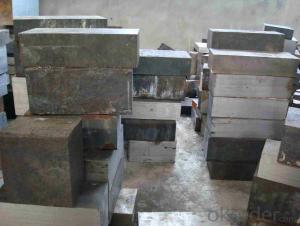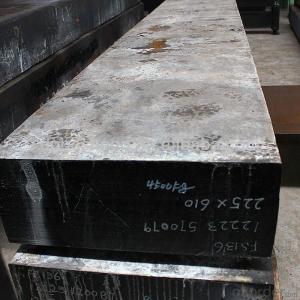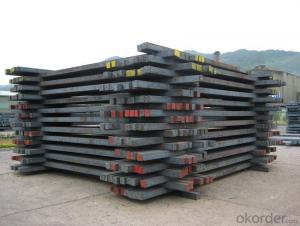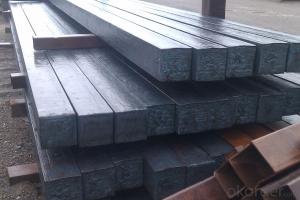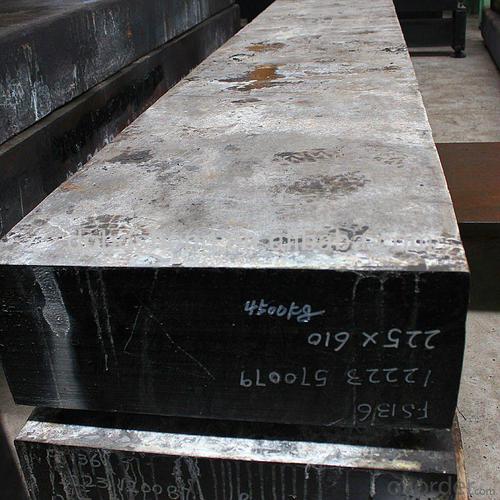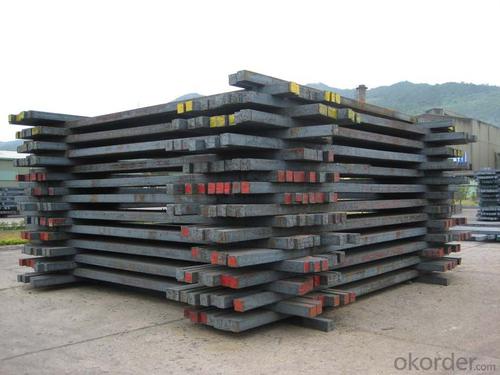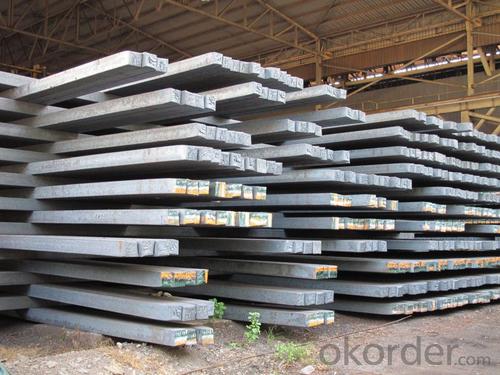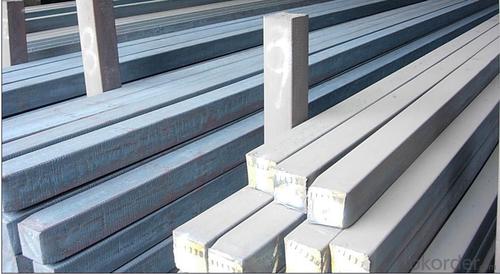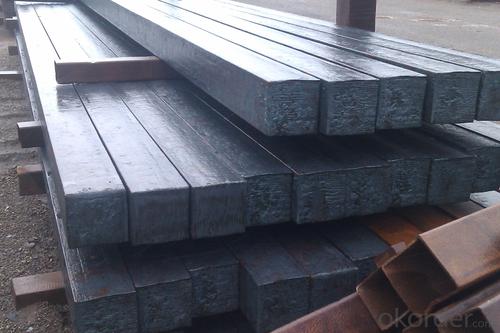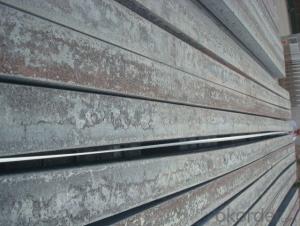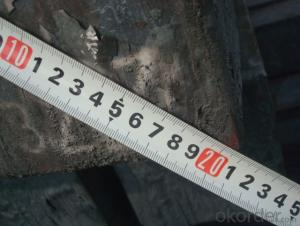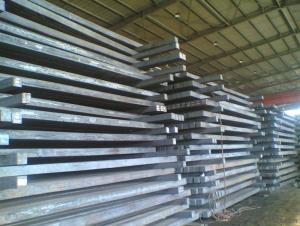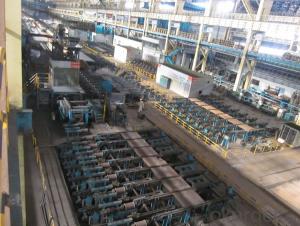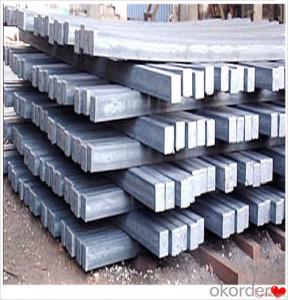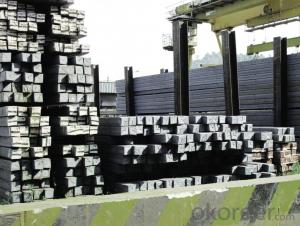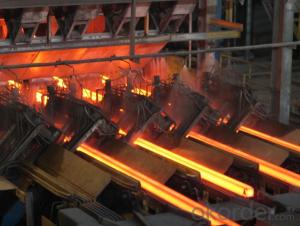Prime Q275 110mm Square Alloy Steel Billet
- Loading Port:
- Shanghai
- Payment Terms:
- TT OR LC
- Min Order Qty:
- 100 m.t.
- Supply Capability:
- 10000 m.t./month
OKorder Service Pledge
OKorder Financial Service
You Might Also Like
Structure of Prime Q275 110mm Square Alloy Steel Billet

Description of Prime Q275 110mm Square Alloy Steel Billet
1. Prepainted steel coil is coated with organic layer, which provides higher anti-corrosion property and a longer lifespan than that of galvanized or galvalume steel sheets.
2. The base metals for prepainted steel coil consist of cold rolled, HDGI Steel, electro-galvanized and hot-dip alu-zinc coated steel. The finish coats of prepainted steel coil can be classified into groups as follows: polyester, silicon modified polyesters, polyvinylidene fluoride, high-durability polyester, etc.
3. The production process has evolved from one-coating-and-one-baking to double-coating-and-double-baking, and even three-coating-and-three-baking.
4. The color of the prepainted steel coil has a very wide selection, like orange, cream-colored, dark sky blue, sea blue, bright red, brick red, ivory white, porcelain blue, etc.
5. The prepainted steel coils can also be classified into groups by their surface textures, namely regular prepainted sheets, embossed sheets and printed sheets.

Main Feature of Prime Q275 110mm Square Alloy Steel Billet
Uncoated CR steel sheet
With the features of in line with the international highest standards in demension and shape, excellent surface finish and properties, the products are mainly used in home appliance and automobile industries.
Galvanized steel sheet(include HDG and EG)
With the features of good corrosion resistance, the products are mainly used in automobile, home appliance, electronics, building and machinery manufacture industries, etc.
Precoated steel sheet
With the features of enviromental protection and good processablility, long lasting surface durability, rich in colors, the products are maily used in building, home appliance and furniture industries, etc.
Applications of Prime Q275 110mm Square Alloy Steel Billet
A. Corrugated design makes it excellent waterproof performance
B. Materials as prepainted steel sheets, galvanized steel sheets, galvalume (Al-Zn coated sheets) are available to make corrugated sheet.
C.Those material are durable, anti-corrosion in bad weather for 20-30 years based on it's Zinc(Galvanized) coating or AZ (Galvalume) coating.
D. Different shape of the sheet make it suitable for any style of buildings.
E.Easy to install, no need special tools to fix the sheet.
F.Light weight due to high strength to weight ratio of steel. Light weight means easier handling lower shipping costs, easier installation
G. Different color is availbe base on the RAL Standard make your building more beautiful.
H. We will provide the best solutions if you don't have a exact idea of the specification you want for the steel sheet based on your weather conditions, engineering structure, construction budget and so on.

Specifications of Prime Q275 110mm Square Alloy Steel Billet
Product | Billet |
Material Grade | SGCC / SGCH / DX51D+AZ, etc |
Thickness | 0.6-3.0mm |
Width | 500-1500mm |
Tolerance | Thickness: +/-0.02mm , Width:+/-2mm |
Zinc-coating | Z30-150g/m2 |
Technique | Raw material: Hot rolled steel coil --> Cold rolled_>hot dipped galvalume |
Surface | Dried, Chromated, Unoiled |
Spangle | Regular spangle , small spangle, zero spangle |
ID | 508MM 610MM |
Coil weight | 1-25MT |
Export package | Cardboard inner sleeves, Waterproof paper, galvanized steel covered and steel strip packed |
FAQ of Prime Q275 110mm Square Alloy Steel Billet
We have organized several common questions for our clients,may help you sincerely:
1. How Can I Visit There?
Our company is located in Tianjin City, China, near Beijing. You can fly to Tianjin Airport Directly. All our clients, from home or aboard, are warmly welcome to visit us!
2. How Can I Get Some Sample?
We are honored to offer you sample.
3. Why choose CNBM?
Our delivery time about 15-20days for standard sizes, if you have other requirements like hardness, quanity and width ,it is about 20-40days. But don't worry we also try our best for the delivery time ,because time longer and our cost is higher.
- Q: How are steel billets used in the manufacturing of gears?
- Steel billets are used in the manufacturing of gears as the raw material for forging or machining processes. They are typically heated and shaped into the desired gear shape, either through hot forging or by cutting and grinding. The steel billets provide the strength and durability required for gears to withstand the heavy loads and high stresses they experience during operation.
- Q: Can steel billets be used in the production of energy-efficient appliances?
- Certainly, energy-efficient appliances can make use of steel billets. Steel, being a versatile material renowned for its strength and durability, is extensively employed in appliance manufacturing. These appliances are designed to minimize energy consumption and greenhouse gas emissions by employing less energy while performing their designated tasks. When it comes to energy-efficient appliances, steel billets can be processed and transformed into numerous components, including outer shells, structural supports, and internal parts. The incorporation of steel ensures the longevity and dependability of these appliances, thereby enhancing their overall energy efficiency. Moreover, steel is highly recyclable, allowing it to be repurposed or reused for other applications once an appliance reaches the end of its lifecycle. Steel recycling aids in energy conservation and waste reduction, further bolstering the pursuit of energy efficiency. To summarize, the utilization of steel billets is indeed feasible in the production of energy-efficient appliances. The exceptional properties of steel, namely its strength, durability, and recyclability, make it an ideal choice for manufacturing appliances that promote a more sustainable future.
- Q: What are the different types of steel billet shearing machines?
- There are several different types of steel billet shearing machines available in the market, each designed to cater to specific needs and requirements. Some of the most common types include: 1. Hydraulic Billet Shearing Machine: This type of machine utilizes hydraulic power to cut steel billets with precision and efficiency. It offers a high cutting force and can handle larger billet sizes. 2. Mechanical Billet Shearing Machine: These machines use mechanical force, such as a flywheel or a cam-operated mechanism, to cut the steel billets. They are typically compact and suitable for smaller billet sizes. 3. Pneumatic Billet Shearing Machine: This type of machine employs pneumatic pressure to shear the steel billets. It is commonly used in applications where hydraulic or mechanical power may not be available or suitable. 4. CNC Billet Shearing Machine: CNC (Computer Numerical Control) machines offer automated and precise cutting of steel billets. They can be programmed to perform complex cuts and are suitable for high-volume production environments. 5. Rotary Billet Shearing Machine: This machine utilizes a rotary blade to cut the steel billets. It offers a continuous cutting motion and is ideal for cutting larger billet sizes or long-length materials. 6. Cold Billet Shearing Machine: This type of machine is specifically designed for cutting cold billets. It uses a combination of hydraulic or mechanical force and can handle materials that may be more brittle when cold. 7. Hot Billet Shearing Machine: Hot billet shearing machines are designed to cut steel billets at high temperatures. They are equipped with specialized blades and cooling systems to handle the heat generated during the cutting process. These are just a few examples of the different types of steel billet shearing machines available in the market. The choice of machine depends on factors such as the size and thickness of the billets, required precision, production volume, and specific application requirements. It is important to consider these factors and consult with a professional to determine the most suitable machine for your needs.
- Q: How are steel billets unloaded at the destination?
- Steel billets are typically offloaded at the destination using different techniques depending on the available infrastructure and equipment. One commonly used approach involves the utilization of cranes or forklifts that are equipped with lifting attachments. These machines have the capability to lift and move the heavy steel billets from the transport vehicle to the designated storage area or processing facility. In certain situations, a specialized unloading facility like a rail yard or port may be utilized. In these cases, cranes or gantry systems are often employed to efficiently transfer the steel billets from rail cars or shipping containers onto trucks or storage areas. This method allows for a more streamlined unloading process, especially when dealing with large quantities of steel billets. Another method that is sometimes employed involves the use of conveyor belts or rollers. This method proves particularly effective when unloading steel billets from a container or truck where they are arranged in a row. The conveyor belt or roller system permits a continuous unloading process, with the billets being moved along the conveyor to the desired location. Irrespective of the method employed, safety precautions are always implemented during the unloading process to ensure the well-being of workers and the prevention of any damage to the steel billets. These precautions may encompass the use of proper lifting techniques, securing the billets during transportation, and the wearing of appropriate personal protective equipment. In summary, the unloading of steel billets at the destination necessitates meticulous planning, efficient machinery, and adherence to safety protocols to ensure a smooth and successful operation.
- Q: How are steel billets used in the manufacturing of pipes?
- Steel billets are an essential component in the manufacturing of pipes. These billets, which are semi-finished products made of steel, serve as the raw material for pipe production. The process begins with the selection of high-quality steel and melting it in a furnace to create a molten steel alloy. Once the steel is molten, it is poured into molds to form billets of specific sizes and shapes. The billets are then allowed to cool and solidify. This solidification process ensures that the steel attains its desired structural properties, such as strength and durability. After the steel billets have cooled, they undergo further processing to transform them into seamless or welded pipes. For the production of seamless pipes, the billets are heated and pierced to create a hollow tube-like structure. The pierced billets are then elongated and stretched to obtain the desired pipe diameter and thickness. This process, known as the hot-rolling technique, results in seamless pipes with consistent dimensions and enhanced mechanical properties. Welded pipes, on the other hand, are manufactured using different methods. One common method is the electric resistance welding (ERW) process, where the billets are first heated and then passed through a series of rollers to shape them into a cylindrical form. The edges of the billets are then fused together using an electric current, creating a continuous weld. Other welding techniques, such as submerged arc welding (SAW) and high-frequency induction welding (HFIW), can also be used to manufacture welded pipes from steel billets. In both seamless and welded pipe manufacturing, the quality of the steel billets is crucial for ensuring the integrity and performance of the final product. The selection of appropriate steel grades and the adherence to strict manufacturing standards are vital to produce pipes that can withstand high pressure, extreme temperatures, and corrosive environments. In conclusion, steel billets play a vital role in the manufacturing of pipes. They serve as the starting material from which pipes are formed, whether through the hot-rolling technique for seamless pipes or various welding methods for welded pipes. By utilizing high-quality steel billets and employing precise manufacturing processes, pipes can be produced with the necessary strength, durability, and dimensional accuracy to meet a wide range of industrial and commercial applications.
- Q: What is the shelf life of a steel billet?
- The durability of a steel billet can vary based on various factors. In order to prevent corrosion and uphold their quality, steel billets are typically stored in controlled environments. With proper storage, steel billets can remain usable for several years. However, it is essential to acknowledge that the shelf life can be influenced by factors such as humidity levels, exposure to moisture or chemicals, and the specific type of steel employed. Consequently, it is crucial to adhere to the storage guidelines provided by manufacturers to guarantee an extended shelf life for steel billets. Regular inspections and maintenance can also aid in identifying any potential issues that may impact the durability of the billets.
- Q: What are the main factors that determine the sustainability of steel billets production?
- The main factors that determine the sustainability of steel billets production include the source of raw materials, energy efficiency in the production process, waste management, carbon emissions, water usage, and adherence to environmental regulations. Additionally, the implementation of sustainable practices such as recycling, reducing greenhouse gas emissions, and promoting responsible sourcing contribute to the overall sustainability of steel billets production.
- Q: How are steel billets used in the production of seamless tubes?
- Steel billets are an important raw material used in the production of seamless tubes. They are primarily used in the initial stage of the manufacturing process, which involves the formation of seamless tubes through the hot rolling or extrusion method. To begin with, steel billets are heated to a high temperature to make them malleable. This process is known as hot rolling, and it allows the billets to be easily shaped and manipulated. The heated billets are then passed through a series of rollers or extrusion dies to form a cylindrical shape, which is the basic structure of a seamless tube. During the rolling or extrusion process, the steel billets undergo substantial deformation. The pressure applied by the rollers or dies forces the metal to flow and fill the cavities, resulting in the formation of a seamless tube. The size and shape of the billets determine the dimensions and specifications of the final seamless tube. Moreover, steel billets also contribute to the mechanical properties of the seamless tubes. The quality and composition of the billets play a crucial role in determining the strength, durability, and corrosion resistance of the tubes. Proper selection and quality control of the billets are essential to ensure the production of high-quality seamless tubes that meet industry standards and customer requirements. In conclusion, steel billets are indispensable in the production of seamless tubes. They are heated, formed, and shaped through the hot rolling or extrusion process, resulting in the creation of seamless tubes with specific dimensions and mechanical properties. The use of steel billets ensures the production of high-quality seamless tubes that are widely used in various industries, including oil and gas, automotive, construction, and manufacturing.
- Q: What are the main factors affecting the surface roughness of steel billets?
- The main factors affecting the surface roughness of steel billets include the quality of the raw materials used, the manufacturing process, the condition of the equipment used, and the skill and expertise of the operators.
- Q: How are steel billets used in the production of mining equipment?
- Due to their strength, durability, and versatility, steel billets are crucial for the production of mining equipment. These billets are typically made by pouring molten steel into a mold, resulting in a solid rectangular shape. They are then used as raw material in the manufacturing process of mining equipment. Mining operations require robust and reliable components for equipment such as excavators, bulldozers, and crushers, to withstand harsh conditions and heavy loads. Steel billets provide the necessary structural integrity and toughness, ensuring efficient and safe equipment operation. Once obtained, steel billets undergo various techniques such as forging, machining, and welding to transform them into specific parts and components. Forging can create heavy-duty gears, shafts, and axles, which are essential for mining equipment. Machining steel billets allows for custom-made components that fit seamlessly into mining equipment. This process involves cutting, drilling, and milling to create parts like buckets, cutting edges, and chassis. In addition, welding steel billets together creates complex structures and ensures equipment integrity and strength. This is particularly important in mining equipment construction, where safety and reliability are paramount. In conclusion, steel billets are vital for producing mining equipment as they provide the necessary raw material. Their strength, durability, and versatility allow for the creation of robust and reliable components that can withstand the demanding conditions of mining operations.
Send your message to us
Prime Q275 110mm Square Alloy Steel Billet
- Loading Port:
- Shanghai
- Payment Terms:
- TT OR LC
- Min Order Qty:
- 100 m.t.
- Supply Capability:
- 10000 m.t./month
OKorder Service Pledge
OKorder Financial Service
Similar products
Hot products
Hot Searches
Related keywords
